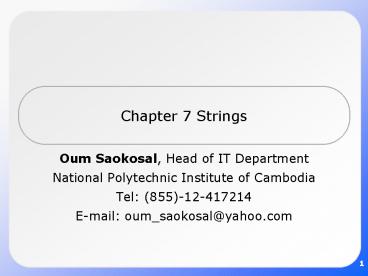Chapter 7 Strings - PowerPoint PPT Presentation
1 / 17
Title:
Chapter 7 Strings
Description:
1. Chapter 7 Strings. Oum Saokosal, Head of ... A string is sequence (series) of characters. A string is NOT an array ... output: Hi5.com. Please make some ... – PowerPoint PPT presentation
Number of Views:56
Avg rating:3.0/5.0
Title: Chapter 7 Strings
1
Chapter 7 Strings
- Oum Saokosal, Head of IT Department
- National Polytechnic Institute of Cambodia
- Tel (855)-12-417214
- E-mail oum_saokosal_at_yahoo.com
2
Strings p.257
- Introduction
- The String class
- The Character class
- The StringBuffer class
3
Introduction
- A string is sequence (series) of characters.
- A string is NOT an array of characters.
- E.g. in C/C char s20
- In Java, A String is an object.
- Java has 3 String classes
- String
- StringBuffer
- StringTokenizer
4
The String class
5
The String class (1)
- String is in java.lang package.
- Since java.lang. is always imported
automatically, we dont need to import the String
class. - Declaration
- String s1
- Initialization
- s1Information Technology
- Or, short-cut
- String s1Information Technology
6
The String class (2)
- Because String is a class, then s1 is an object.
- So there should be constructors, methods, or
properties. - String constructors
- String()
- String(String value)
- String(char value)
- Ex String s1 new String(IT)
- You just say
- String s1 IT
7
The String class (3)
- Summary of String class
- Constructors
- String()
- Methods
- charAt()
- compareTo()
- concat()
- endsWidth()
- equals()
- getChars()
- equalsIgnoreCase()
- getChars()
- indexOf()
- lastIndexOf()
- regionMatches()
- length()
- replace()
- startsWith()
- subString()
- toCharArray()
- toLowerCase()
- toString()
- toUpperCase()
- trim()
- copyValueOf()
- valueOf()
8
The String class (4)
- Q. How do I get those methods to use?
- A. You just declare a variable as String.
- String s1npic
- Then, you call a method, say length().
- System.out.println(s1.length())
- Lets try this out
- Public class TestString
- public static void main(String args)
- String s1npic
- System.out.println(s1.length())
9
The String class (5)
- Note
- The String class is immutable (has no setter
method). - The String class is final so we cannot inherit
from it. //Discuss it in chapter 8 - Lab time
- Example 7.1 Checking Palindromes p.266
10
The Character class
11
The Character class
- To declare a variable as a character, use
primitive data type char. - Ex char ch1 a
- But Java provides also Character class. It is
useful for Data Structure. - Ex Character ch2 new Character(b)
- Character ch3 c
- After define ch2,ch3 as Character, then these can
use methods from Character class. Please see
methods on page 268. - Lab Time
- Example 7.2 on page 268
12
The StringBuffer class
13
The StringBuffer class (1)
- StringBuffer class is more flexible than String
class. Why? - Because after creating a variable from
StringBuffer class, we can use append, delete,
insert etc. very easily. - Example
- StringBuffer sb new StringBuffer(NPI)
- sb.append(C)
14
The StringBuffer class (2)
- StringBuffer()
- append()StringBuffer
- capacity()int
- charAt()char
- delete()StringBuffer
- deleteCharAt()StringBuffer
- insert()StringBuffer
- length()int
- replace()StringBuffer
- reverse()StringBuffer
- setCharAt()void
- setLength()void
- subString()String
Homework
15
The StringBuffer class (2)
- Append
- StringBuffer st new StringBuffer("H")
- st.append('i')
- st.append(5)
- st.append(".")
- st.append("com")
- //output Hi5.com
- Please make some note on the code.
- StringBuffer provided overloaded methods to
append boolean, char, char, double, float, int,
long, String.
16
Lab Exercise 1
- Count the number of words in a given String
- Example
- Input National Polytechnic Institute of
Cambodia - Output Word Count 5 words
17
Lab Exercise 2
- On page 285, Section 7.4 The StringBuffer Class
- 7.11 (Sorting character in a String) Write a
method that returns a sorted string using the
following header - public static String sort(String s)
- For example, sort(bac) return abc.































